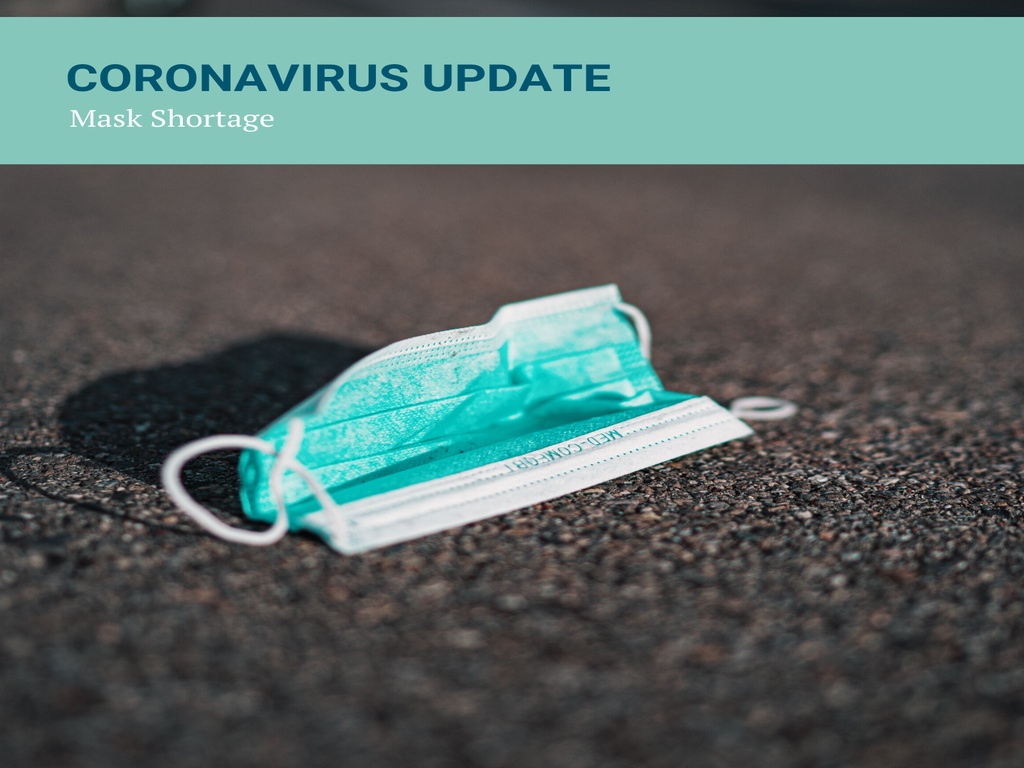Coronavirus Update: Mask Shortage

We have received numerous support calls regarding the mask shortage. Please read this information carefully.
Coronavirus Disease 2019 (COVID-19) is a respiratory disease caused by the SARS-CoV-2 virus. Symptoms include fever, cough, and shortness of breath. Some people have reported other symptoms while others report no symptoms at all. CDC indicates that symptoms of COVID-19 may appear in as few as 2 days or as long as 14 days after an exposure.
The virus is thought to be spread person-to-person including close contact with one another (6 feet) and through respiratory droplets produced when an infected person coughs or sneezes. It is possible that a person can get COVID-19 by touching a surface or object that has SARS-CoV-2 on it and then touching their own mouth, nose, or possibly their eyes, but this is not thought to be the primary way the virus spreads, so states CDC.
Many have questioned OSHA’s position regarding the mask shortage. We contacted TOSHA to express these concerns. OSHA has referred us to the Bloodborne Pathogens Standard for their position. According to 1910.1030(d)(3)(x): Masks, Eye Protection, and Face Shields. Masks in combination with eye protection devices, such as goggles or glasses with solid side shields, or chin-length face shields, shall be worn whenever splashes, spray, spatter, or droplets of blood or other potentially infectious materials may be generated and eye, nose, or mouth contamination can be reasonably anticipated.
Keep in mind that single-use masks cannot be reused. We are concerned that if workers are reusing masks, they are subjecting themselves and the patient to cross-contamination. At least with the chin-length face shields, the shield can be disinfected between patients. If you implement N95 filtering facepiece respirator masks, fit testing is required. You will need to add a medical evaluation and fit testing policy to your safety manual. Granted, these are basic PPE requirements. This is not the case when treating a known infected patient with SARS-CoV-2. OSHA issued additional guidance last week, Guidance on Preparing Workplaces for COVID-19. See www.osha.gov/Publications/OSHA2990.pdf.
OSHA’s Guidance on Preparing Workplaces
OSHA requires employers to provide their workers with PPE needed to keep them safe while performing their jobs. The types of PPE required during a COVID-19 outbreak will be based on the risk of being infected with SARS-CoV-2 while working and the job tasks that may lead to exposure.
If you are working with patients known to be or suspected of being infected with SARS-CoV-2 and those performing aerosol-generating procedures need to use respirators. OSHA emphasized that N95 filtering facepiece respirators or better must be used in the context of a comprehensive, written respiratory protection program that includes fit-testing, training, and medical exams. When the disposable N95 filtering facepiece respirators are not available, consider using other respirators that provided greater protection and improve comfort such as R/P95, N/R/P99, or N/R/P100 filtering facepiece respirator; an air-purifying elastomeric (e.g., half-face or full-face) respirator with appropriate filters or cartridges; powered air-purifying respirator (PAPR) with high-efficiency particulate arrestance (HEPA) filter; or supplied-air respirator (SAR). See www.cdc.gov/coronavirus/2019-ncov/hcp/respirators-stragegy. CDC has also issued guidance.
ADA’s Guidance
According to ADA, if urgent dental treatment is necessary, the dental and medical providers work together to determine the appropriate precautions to take and decide whether the dental facility is an appropriate setting to provide the necessary services to the potentially infectious patient. Most dental settings are not designed to carry out all of the transmission-based precautions recommended for hospitals and other ambulatory care settings.
ADA emphasized CDC’s recommendation that all healthcare workers including dentists and staff should receive the flu vaccine. Workers experiencing flu-like symptoms should not report to work. As of March 3rd, the immediate health risk to the coronavirus to most of the American public was considered low.
Classifying Worker Exposure
According to OSHA, the risk to occupational exposure to SARS-CoV-2, the virus that causes COVID-19, during an outbreak may vary from very high to high, medium, or lower (caution) risk. The very high exposure risk includes doctors, nurses, dentists, paramedics, emergency medical technicians) performing aerosol-generating procedures on known or suspected COVID-19 patients. OSHA sets forth the proper engineering controls, administrative controls, and safe work practices. Note that the risk is based on performing the described procedures on known or suspected patients.
Screen Patients
Dentists should screen all patients for recent travel to any locations confirmed by the CDC to have confirmed cases of COVID-19. You may access up to date information at www.cdc.gov/coronavirus/2019-ncov/locations-confirmed-cases.html. Patients have returned home at least two weeks and no symptoms have presented, the patient may proceed with dental treatment. On the other hand, patients who have symptoms of fever, cough, shortness of breath or are experiencing acute respiratory illness should remain home and postpone their dental appointment.
Summary
In summary, we find these important highlights:
- Wear a mask and do not re-use single-use masks
- If there is a shortage of masks, use a full-face shield
- If you suspect the patient has COVID-19 and the patient requires emergency treatment, refer the patient to a hospital setting
- If you implement N95 masks, implement fit testing and medical evaluations in addition to adding the necessary policy to your OSHA manual
- Sick employees should not report to work
- Screen your patients to determine if they have traveled to a high-risk country within the last 2 weeks and if so, postpone treatment
We at Modern Practice Solutions are committed to assisting you to remain in compliance. Please let us know if you have additional questions. Also, please contact the office if you need to add the N95 fit testing and medical evaluations in order to add the N95s to your PPE program.




